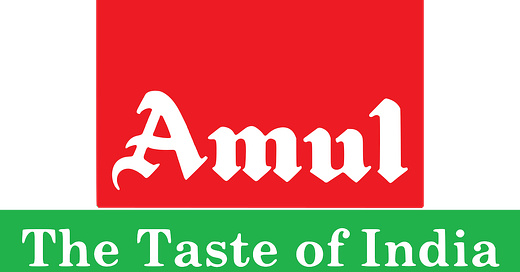Supply Chain Strategy of Amul
Amul is a dairy cooperative based in the Anand district of Gujarat, India. The word AMUL is derived from the Sanskrit word “amulya”, meaning invaluable. The cooperative was initially referred to as Anand Milk Federation Union Limited and hence the name AMUL.

The ultimate goal of the Amul is to benefit the farmers through this hierarchical supply chain that includes different kinds of entities ranging from small suppliers to large fragmented markets. It changed the supply chain paradigm in order to reduce the cost to the consumer while increasing the return to the supplier.

The key supply chain strategies of Amul are:
Core activities and third-party service providers: Amul chose a strategy to focus on core dairy activities and rely on third parties for other complementary needs. For example, AMUL focused on the processing of liquid milk and conversion to a variety of dairy products and associated research and development. On the other hand, logistics of milk collection and distribution of products to customers was managed through third parties.
Assistance to stakeholders: To the wholesalers and retailers, Amul offers reasonable margins on a high volume good. It offers support in demand prediction, reducing the potential bullwhip effects that might arise from inexperienced sales partners. It also offers easy repayment programs for capital investments in infrastructure (freezers etc) by the retailers.
Increasing the Supply of Milk: Increasing the supply of product leads to better economies of scale (optimizing sunk costs). To this end, the unions provide various aids to the milk producers (like cattle-feed, veterinary aid, technical training) obtained at a low cost due to large scale sourcing, to increase supply. Aids are also aimed at overall community development.
Bridging Gaps in a Fragmented/Unstable Supply-Side Market: Given the fragmented nature of the producers, supply tends to vary based on various factors, but demand remains fairly constant. The unions have invested in cold storage facilities to ensure that surpluses can be stored and redistributed to village level centres that are facing a shortage of supply, efficiently reducing supply instabilities.
Technology Initiatives: An automatic Milk Collection System was established that could identify and test the quality/quantity of milk. This leads to time-saving since over 1000 producers enter a village cooperative each day and increased transparency.
Enterprise-wide Integrated Application Systems were used to align various sub software systems in place. A Geographic Information System was also established to view supply disparities in real-time. Cyber stores have been recently launched as well.
Sources: https://www.slideshare.net/pramodvishe/amul-supply-chain-management, https://www.coursehero.com/file/11895199/A-Project-Report/.
An Article By: B-Events Team
DISCLAIMER
Shaastra TechShots’ publications contain information, opinions and data that Shaastra TechShots considers to be accurate based on the date of their creation and verified sources available at that time. It does not constitute either a personalized opinion or a general opinion of Shaastra or IIT Madras. The information provided comes from the best sources, however, Shaastra TechShots cannot be held responsible for any errors or omissions that may emerge.



